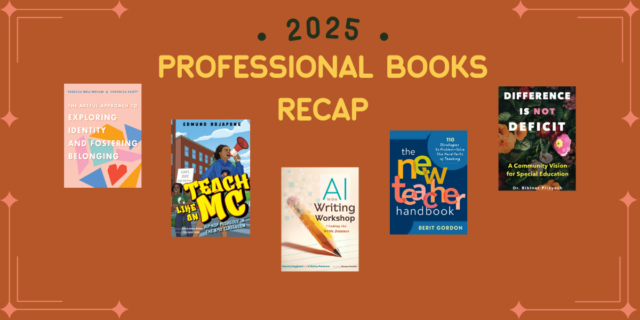
The following is adapted from The New Teacher Handbook by Berit Gordon. This is a very condensed list—ideas for coaches and administrators accompany all 110 strategies throughout the book. See part two on building relationships here.
Time Management & Planning Workloads
- Make time management feel like an ongoing and normal challenge that we all work on, not an isolated new teacher problem. Think about the last time you were late for an appointment, or didn’t get to everything you meant to during a meeting. Make sure you’ve seen their class or at least discussed in detail what makes it run long.
- Together, list upcoming and pressing tasks on the teacher’s to-do list. Map out how long those tasks will take from start to finish. Choose a short task for them to do while you are sitting together. Remind them when the time is up and encourage them to be done, no matter what.
- Make a list of all the demands on the new teacher’s time, professionally and otherwise, and rank them together. Which are most important to the new teacher’s well-being and that of students? Don’t worry that you are telling this teacher to slack off by putting some in the “Comply but as a C student” column. This is a realistic coping strategy we all use when we’re at our limit.
- Look at students’ work together before planning an upcoming lesson. What do they know? What are they ready for? Determine that together and then plan accordingly. Follow up to see how engaged students are and celebrate the results.
- Help teachers identify the overview and learning goals in a curriculum. See if they can tell the unit’s story in their own words, and if not, go back together to practice. Talk about what parts of the curriculum weren’t used and what was helpful.
- Teachers may feel too overwhelmed with classroom management concerns to try group work. Help reframe small groups as a way to potentially reduce management issues—when students are actively engaged in purposeful tasks together, there’s often less off-task behavior. Look at their upcoming lesson and identify a 5–10 minute segment where students could work in pairs before trying larger groups.
- Take a practice test together. Jot down what you noticed in terms of skills and academic vocabulary. Compare lists. Where are these taught in the curriculum? If they aren’t explicitly covered, when can they be tucked in?
- Help reframe selective grading as a way to increase practice opportunities—when students know not everything is graded, they’re more willing to take risks and try challenging work. Review an upcoming unit together and identify where to streamline assessments. Focus on finding efficient ways to check understanding without creating grading overload.
Feedback & Assessment
- Students and teachers deserve frequent informal checks to determine what they know and need. If observations are your only opportunity to see what teachers have in place and need, this is a high-stakes recipe for new teacher burnout. Check with your new teachers frequently by looking at student work together, having informal discussions, and seeing the teachers in action.
- Ask teachers for feedback. Remind them this is to help you be a better leader. Include questions that won’t hinder honest input from teachers who may feel intimidated. “What keeps you energized about teaching, and what takes energy away?” “What do you like most or least about teaching here?” “What specifically can I do to support you better?” Then make a change! Ask these questions early and often, not when new teachers are at the end of their rope or handing in their resignations.
- Ask, “What can I do better?” Listen to any answer and note if the teacher is reluctant to answer honestly. Thank them for any answer they provide. If they say a little bit, encourage them by saying, “Tell me more about that,” or “What else?” If they don’t yet have an answer, encourage them to let you know later in an email or say that you’ll ask again next time when they’ve had time to think
Building Structure
- Before you do any new teacher induction training or support, list what they need to know for various parts of the day and year. Make lists for what they should know before parent-teacher conferences, before the first semester ends, before testing, and so on.
- If meetings typically start right with business or with aimless drifting in, have teachers share a quick success from their classrooms (or daily life) or say two words about how they feel right now. Reflect on any different tone or new level of engagement when a meeting starts with a welcoming routine.
- Reflect on the meetings you lead and how you can pace them even better so that teachers will feel the time is well spent and the energy stays high. Is everything ready before the start? Do people know the time frames for each part? Do you hold yourself and others to them? Do individual questions and comments come from the same people?
- How do you pose questions in meetings? Is there a system for everyone to be heard, or do certain voices dominate? We have to be careful not to assume that some teachers are quiet because they don’t want to talk or have nothing to say. Often, those are the people we most need to hear from! New teachers especially need support to feel their ideas matter.



